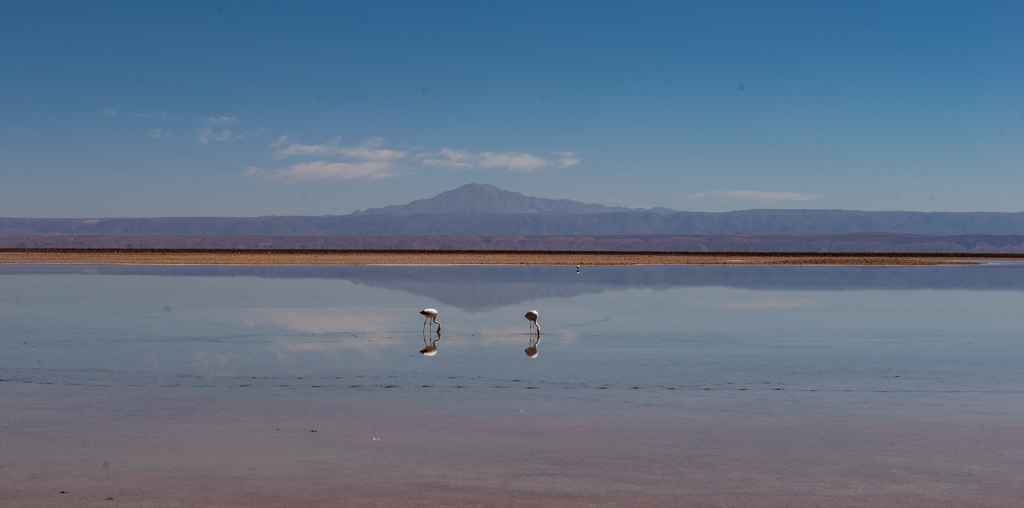|
Carina (the "Keel")
Time: not recorded
S&T Chart Reference: 28, 30, 38, 39, 40
Instrument: Visual
The triangle formed by α, β and ε Carinae was readily identified. θ Carinae was identified because of the visibility of the Southern Pleiades.
Large Magellanic Cloud (LMC) / PGC 17223 / Nubecular Major
Small Magellanic Cloud (SMC) / PGC 3085 / Nubecual Minor
Time: not recorded
S&T Chart Reference: 10, 20, 30
Instrument: Visual
The LMC and SMC are ever present in the night skies. They cannot be missed in these skies. The galaxies stand out.
Orion & M42 (Orion Nebula)
Time: not recorded
S&T Chart Reference: 14, 16, B
Instrument: Visual + Binoculars
Orion was once again seen visually lying on his side; the belt and sword were very visible. I used my binoculars to see the nebulosity of M42 - beautifully clear!
|
Coalsack Nebula & Crux
Time: not recorded
S&T Chart Reference: 49, 50
Instrument: Visual
Interesting that I found this dark area that I thought was the nebula then verified I was the correct by finding Crux adjacent to it. Stars of Crux very bright and easily picked out on the 'border' of the Coalsack.
Corvus (Crow)
Time: not recorded
S&T Chart Reference: 47
Instrument: Visual
All 5 stars easily identified in the dark skies.
Musca (the "Fly" or "Mosquito")
Time: not recorded
S&T Chart Reference: 50
Instrument: Visual
All the bright stars easily identified for this constellation.
|
|
Herschel's Jewel Box / NGC 4755
Time: not recorded
S&T Chart Reference: 38
Instrument: Visual
The Jewel Box was easily located visually. Didn't use binoculars to view this splendid cluster.
Jupiter (in Libra)
Time: not recorded
Instrument: Visual
Jupiter was once again very bright. It was about 18º above the horizon in Libra.
|
Centaurus
Time: 9:52 PM EST
S&T Chart Reference: 48, 49, 59
Instrument: Visual
While with Charline, Dave and Melody, I found Crux then identified all the stars of the Centaur. Such an interesting constellation. α Centauri and β Centauri were easily seen in the night sky!
Omega Centauri
Time: not recorded
S&T Chart Reference: 48, 49, 59
Instrument: Visual + Binoculars
Held up the binoculars after visually locating the cluster - and found it. Such a thrill to see!
|
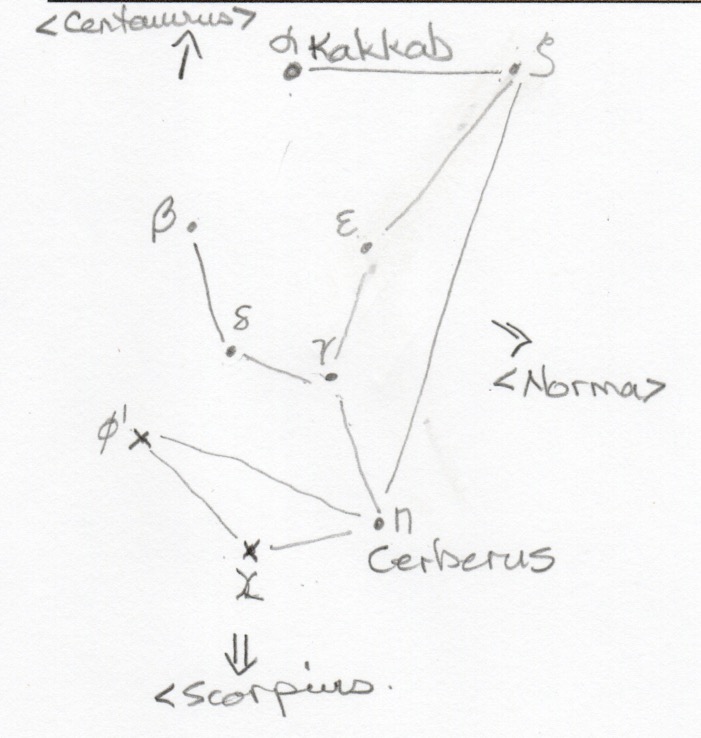 |
Lupus (the Wolf)
Time: 10:02 PM EST
S&T Chart Reference: 48, 59
Instrument: Visual
Charline introduced me to this constellation and showed me where the stars were located. Not all were easily seen on the edge of the Milky Way.
|
|
Triangulum Australe
Time: 10:03 PM EST
S&T Chart Reference: 60
Instrument: Visual
This was also on the list of constellations I wanted to find tonight. I found the Triangulum which then allowed me to find Circinus.
Stars in Triangulum Australe:
- α Trianguli Australis (Atria): orange second-magnitude giant star at mag 1.91
- β Trianguli Australis: double star. Primary is a main-sequence star with mag 2.38. Companion is a 13th mag star.
- γ Trianguli Australis: white main sequence star with mag 2.87
- δ Trianguli Australis: 4th brightest. Yellow giant star at mag 3.8
- ε Trianguli Australis: optical double. "A" is an orange K-type sub giant wth mag 4.11. "B" (or HD138510) is a white main sequence star ar mag 9.32
|
Note: Atria = A(lpha) Tri(anguli) A(ustralis)
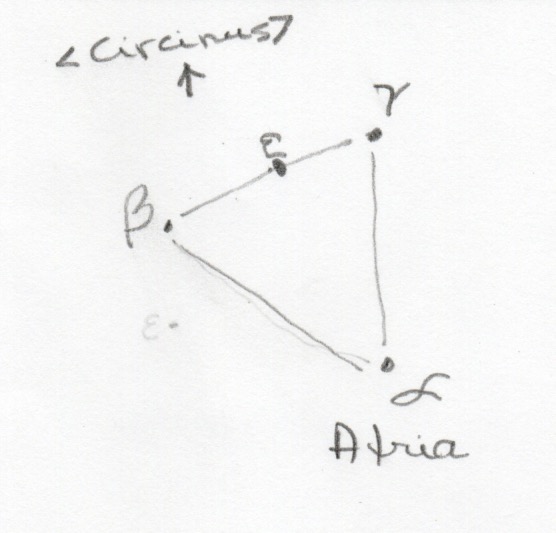
|
|
Circinus (Compass)
Time: 10:09 PM EST
S&T Chart Reference: 48, 50
Instrument: Visual
This was also on the list of constellations I wanted to identify tonight. It was located between Triangulum Australe and Centaurus. It was also very small and faint.
Stars in Circinus:
- α Circini: brightest star at mag 3.19, slightly variable
- β Circini: white sequence star with mag 4.07
- γ Circini: binary star with mag 4.51 (blue component) and 5.5 (yellow star)
- δ Circini: multiple star with components mag 5.1 and 13.4; orbits around a common centre of gravity every 3.9 days
- θ Circini: an irregular variable with mag 5.0-5.4
|
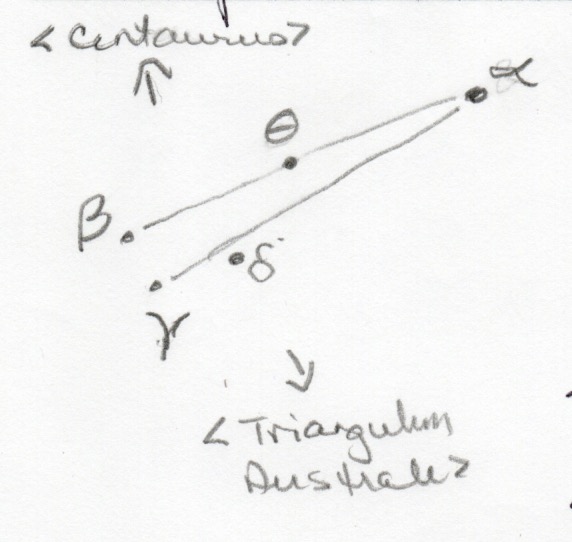
|
|
Lepus (the Hare)
Time: 10:15 PM EST
S&T Chart Reference: 16
Instrument: Visual
Another on the list of constellations I wanted to identify while in the Atacama. I had never observed it at home. It was interesting to see it on its side per se and so easily seen beside the reclined Orion.
Stars in Lepus:
- α Leporus (Arneb): brightest star at mag 2.589. It's a very old and dying star.
- β Leporus (Nihal): orange giant with apparent mag 2.84. It's a double star, maybe binary.
- ε Leporus: orange giant with mag 3.166
- μ Leporus: blue-white sub-giant with apparent mag 3.259
- η Leporus: yellow white dwarf with mag 3.719
- δ Leporus: orange sub-giant with mag 3.81
- γ Leporis: yellow-white main sequence star with mag 3.59
- κ Leporis: binary star with mag 4.43 and 7.00
- λ Leporis: blue-white sub-giant star with apparent mag 4.29
- θ Leporis: blue-white main sequence star with mag 4.67
|
NOTE: This is the Southern Hemisphere orientation.
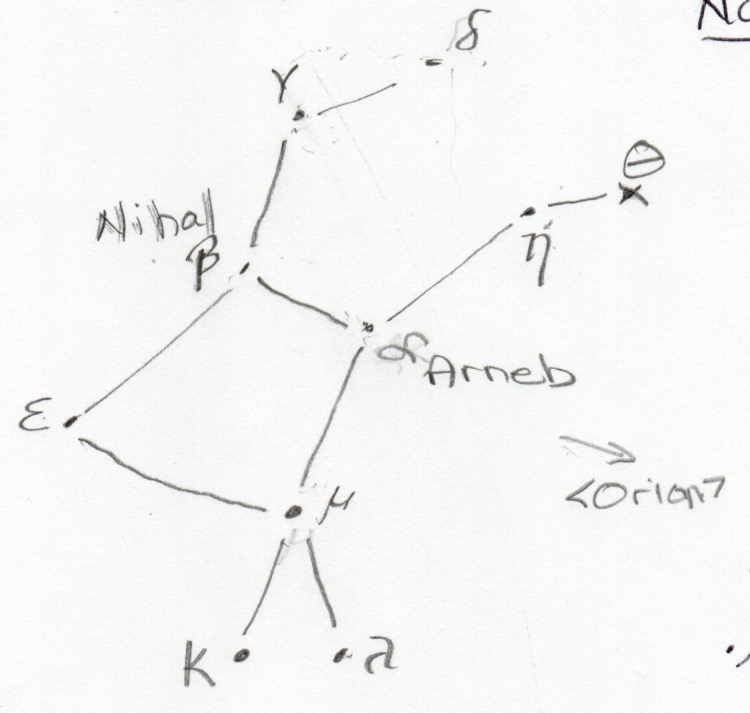
Asterism in Lepus - Known as the Throne of Jawza or the Camels (from the Arabic phrase meaning "camels quenching their thirst")
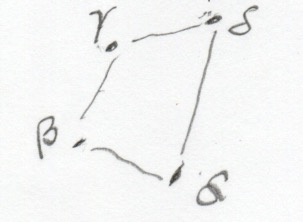
|
|
Vela (the "Sails")
Time: 10:44 PM
S&T Chart Reference: 28, 29
Instrument: Visual
Another constellation I had hoped to find this evening. 32nd constellation in size. This was once a section in the much larger Argo Navis.
To find it, it helped knowing its relative position to Carina and the η Carina Nebula. Still needed to stare a long time at that part of the sky to determine its general location using the shape of the constellation, then finding the specific stars. Didn't locate them all initially but did find most as the night wore on.
|
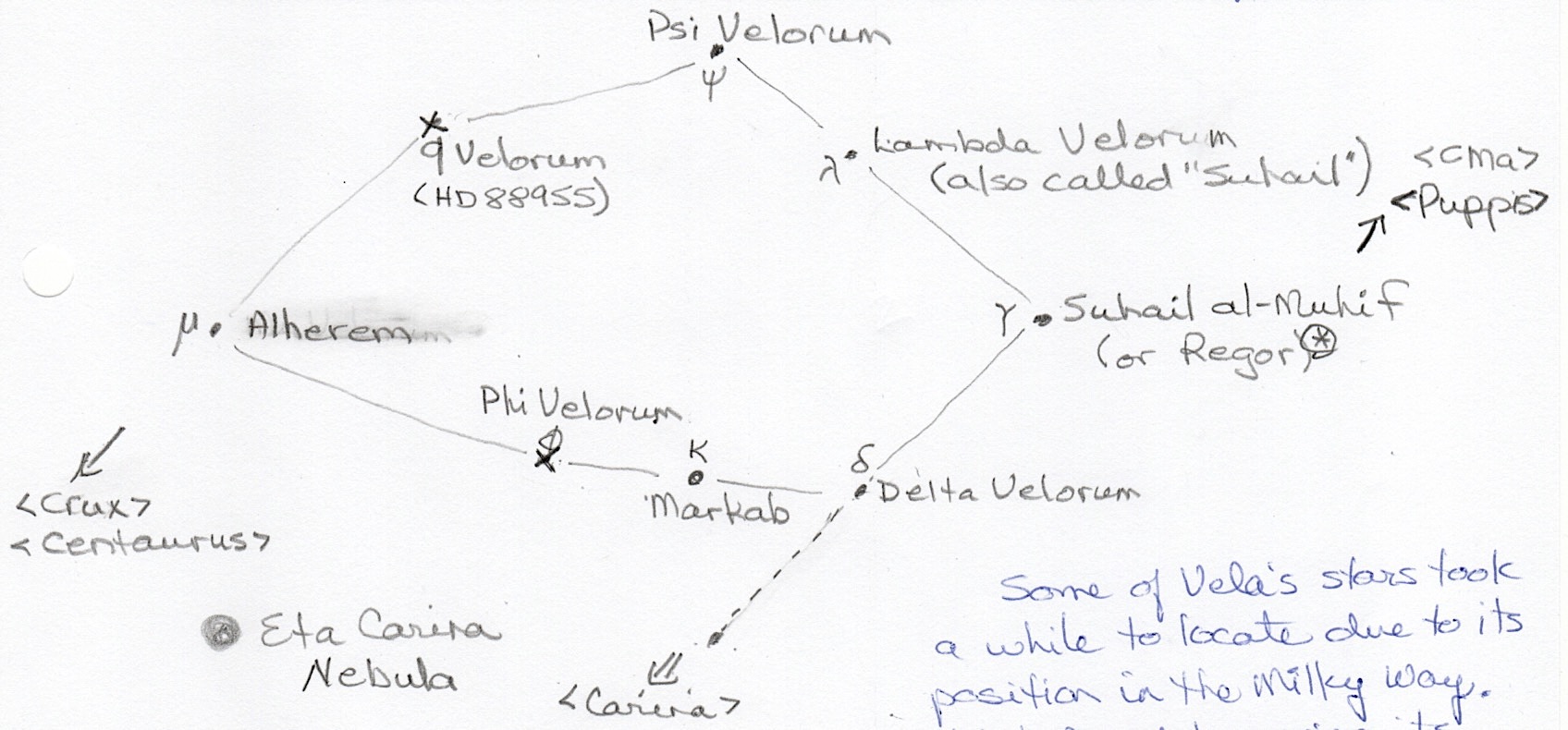
*Suhail has the modern name of "Regor" ("Roger" spelled backwards). It honours Apollo 1 astronaut Roger Chaffee. Originally inserted in NASA star charts by Gus Grissom as a practical joke, but has endured as a memorial to both men who died in the Apollo 1 fire.
|
|
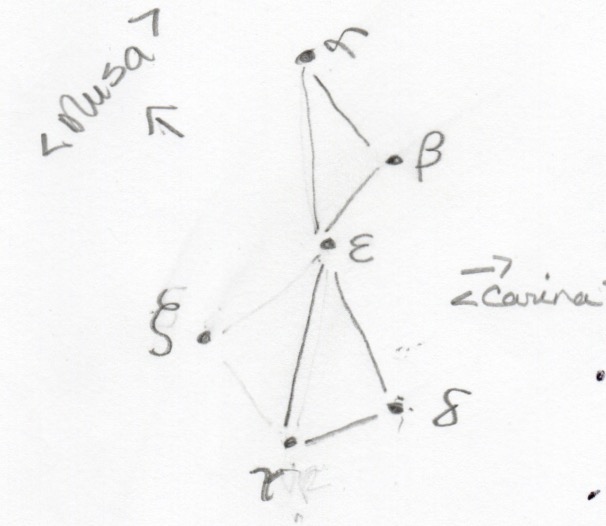
|
Volans ("Flying Fish")
Time: 10:50 PM
S&T Chart Reference: 30
Instrument: Visual
Yet another constellation only list to find this evening. 76th constellation in size.
Stars in Volans:
- β Volantis: Brightest star in the constellation; orange giant with mag 3.77
- α Volantis: It's an A-type chemically peculiar star at mag 4.00
- γ Volantis: Binary star. Primary is an orange giant with mag 3.378; second star is a yellow-white main sequence stat with mag 5.68.
- δ Volantis: 4th brightest, Yellow giant star at mag 3.8
- ε Volantis: Triple star system with an apparent mag of 4.35
- ζ Volantis: Binary star (orange giant with a 10th mag companion) with apparent mag 3.93
|
|
Puppis (the "Poop Deck" or "Stern")
Time: 11:25 PM
S&T Chart Reference: 26, 27, 28, 29
Instrument: Visual
This is a very large constellation that was once part of the larger constellation Argo Navis before it was divided into Puppis, Carina, and Vela. This was on the list of constellations I wanted to identify while in the Atacama, especially since I had seen Azmidis, Asmidi (ξ), and what I believed was Ι Puppis (but cannot now find in star charts) in November 2017 at Peggy's Cove. It was found and the main stars identified.
 |
Stars in Puppis:
- ζ Puppis (Naos): variable star at mag 2.21
- ξ Puppis (Azmidi): very luminous yellow Supergiant star, mag 3.34
- π Puppis (Ahadi): less laminar orange-red Supergiant star with mag 2.71
- ρ Puppis (Tureis): variable double star, mag 2.83
- τ Puppis: Orange-red binary star with mag 2.94
- ν Puppis: blue giant star, mag 3.17
- σ Puppis (Hadir): orange-red binary star system, mag 3.25
- a Puppis: double star, mag 3.62
- c Puppis: variable star, mag 3.62
- HR 2948: Variable double star, mag 4.4
- L2 Puppis: Red variable star
|
|
Ursa Major
Time: 11:20 PM
S&T Chart Reference: 31, 32, 33, 43, F
Instrument: Visual
As was the case last evening, the Dipper was pointing down with Dubhe once more partially shielded by the trees. Mizar and Alcor were once again only about 2º above the horizon.
|
|
|
Boötes
Time: 11:25 PM
S&T Chart Reference: 42, 44, 53, 55
Instrument: Visual
Noticed a very bright star in the NE. Used SkySafariPro to determine it was Arcturus. Looked more towards the north, found Ursa Major then "arced to Arcturus" to confirm. The surprise for tonight was the orientation of Boötes. It was in essence upside-down, looking like a clip-on necktie versus the kite we see up North.
|
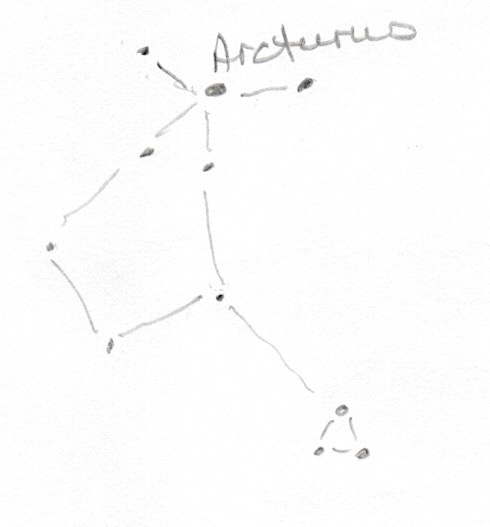
|
 Constellations: Boötes, Centaurus, Circinus, Corvus, Crux, Lepus, Lupus, Musca, Orion, Puppis, Triangulum Australe, Ursa Major, Vela, Volans
Constellations: Boötes, Centaurus, Circinus, Corvus, Crux, Lepus, Lupus, Musca, Orion, Puppis, Triangulum Australe, Ursa Major, Vela, Volans